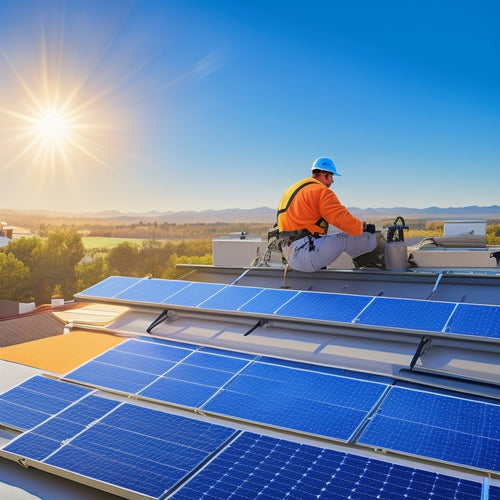
Designing Energy Systems Like a Pro: 3 Essential Tips
Share
To design an energy system like a pro, you'll need to master three essential aspects. First, get system sizing and layout right by performing precise load calculations and optimizing cable management. Next, fine-tune components to boost energy output and efficiency, and balance the system load for efficient energy generation and use. Finally, mitigate potential failures by identifying and prioritizing risks, duplicating critical components, and ensuring seamless takeover in case of component failure. By focusing on these critical areas, you'll be well on your way to creating a reliable and efficient energy system - and there's even more to explore.
Key Takeaways
• Perform precise load calculations to determine required component capacity and ensure system reliability.
• Optimize system components to enhance energy output and efficiency, reducing energy losses and costs.
• Conduct Fault Tree Analysis to identify and prioritize potential failures, and implement redundancy strategies to mitigate risks.
• Ensure effective cable management with proper routing and labeling to improve system reliability and facilitate maintenance.
• Implement smart energy management systems for real-time monitoring and data-driven decision-making to optimize system performance.
Mastering System Sizing and Layout
When designing an energy system, you must accurately size and layout each component to guarantee peak performance, as undersized or oversized components can lead to reduced efficiency, increased costs, and even system failure. To achieve this, you'll need to perform precise load calculations to determine the required capacity of each component. This involves calculating the total power demand of your system, taking into account factors such as usage patterns, peak hours, and equipment specifications.
By doing so, you'll be able to specify the correct cable sizes, ensuring that your system can handle the maximum expected load without overheating or malfunctioning.
Effective cable management is also vital in maintaining a well-designed energy system. You should make sure that cables are properly routed, secured, and labeled to prevent damage, electromagnetic interference, and safety hazards. A well-organized cable management system won't only improve system reliability but also facilitate easier maintenance and troubleshooting.
Optimizing Energy Output and Efficiency
By fine-tuning system components and optimizing operational parameters, you can greatly enhance energy output and efficiency, ultimately leading to reduced energy losses and lower operating costs. This is particularly vital in energy harvesting systems, where maximizing energy output is essential.
To achieve this, you'll need to carefully balance your system's load to make certain that energy is being generated and used efficiently.
Load balancing is essential in energy systems, as it prevents energy waste and reduces the strain on your system. By distributing the energy load evenly, you can reduce energy losses and increase overall efficiency. This, in turn, will lead to lower operating costs and a more sustainable energy system.
To optimize energy output and efficiency, you should also consider implementing smart energy management systems that can monitor and adjust your system's performance in real-time. By taking a proactive approach to energy management, you can identify areas of inefficiency and make data-driven decisions to optimize your system's performance.
Mitigating Potential System Failures
As you've optimized your energy system's performance, it's now imperative to identify and mitigate potential failure points that can undermine your system's reliability and efficiency. You must anticipate and address potential system failures to guarantee uninterrupted energy supply.
To do this, you'll need to conduct a thorough Fault Tree Analysis (FTA). This method helps you identify possible failure scenarios and their likelihood, allowing you to prioritize and mitigate potential failures. By mapping out potential failures and their consequences, you'll be better equipped to develop targeted strategies to prevent them.
One effective approach is to incorporate Redundancy Strategies into your system design. This involves duplicating critical components or systems to ensure that if one fails, another can take over seamlessly. By building in redundancy, you can significantly lessen the risk of system failure and assure a reliable energy supply.
Frequently Asked Questions
What Software Is Best for Designing Energy Systems?
When you're designing energy systems, you'll want software that excels in energy modeling and system simulation. You'll find that tools like OpenStudio, EnergyPlus, or TRNSYS are excellent for accurate energy analysis and system optimization, helping you create efficient energy systems that meet your clients' needs.
How Do I Ensure Compliance With Local Building Codes?
Did you know that 95% of building projects face permit-related delays? To avoid this, you'll need to conduct thorough Code Research, ensuring your energy system design meets local building codes, and navigate the Permitting Process with precision to avoid costly setbacks.
Can I Integrate Energy Storage With My System Design?
When integrating energy storage, you'll need to prioritize battery sizing to guarantee peak performance, and prioritize grid resiliency to guarantee a reliable supply of power, even during outages or peak demand periods.
What Are the Benefits of Using a Microgrid System?
By opting for a microgrid system, you'll achieve energy independence and enhance grid resilience, ensuring a reliable supply of power even during outages, and giving you peace of mind knowing you're in control of your energy needs.
How Do I Select the Right Type of Energy Metering Equipment?
When selecting energy metering equipment, you'll want to prioritize meter accuracy to guarantee reliable data. Look for meters with high data granularity to capture detailed energy usage patterns, allowing you to make informed decisions about your energy system.
Related Posts
-

Top 10 Tips for Buying Car Accessories Online
When purchasing car accessories online, you should take proactive steps to avoid low-quality or incompatible products...
-

What You Need to Know About RV Solar Maintenance
When you're out on the road, your RV's solar panel system is your lifeline. But without regular maintenance, you're l...
-

3 Essential Steps for Solar Electricity Installation
To guarantee a successful solar electricity installation, you'll need to follow three essential steps. First, assess ...


